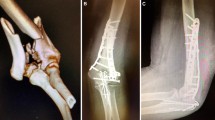Abstract
Introduction
Patients with proximal humeral fractures are mostly elderly. In addition to the proximal humeral fracture, they often have other injuries related to poor bone quality. The surgical treatment of proximal humeral fractures in elderly patients with comminuted fractures is associated with several problems and a high frequency of complications. The aims of this study were to evaluate patients with a proximal humeral fracture treated in a hospital, assess the outcome of the fracture treatment, and decide whether surgical treatment of displaced proximal humeral fractures is superior to conservative treatment or not.
Materials and methods
Patients with fractures of the proximal part of the humerus treated in our hospital were followed during two different periods (14 and 10 months). The study in the first time period was retrospective in design, while in the second period the patients were followed prospectively. Seventy patients, (71% women) with a mean age of 71 years, were included in the study. A functional test was performed within 12–14 months after the injury using a modified Rowe shoulder score. Surgical treatment was performed in 15 patients (21%). Neither the surgical approach nor the implants used for osteosynthesis were standardized. Fifty-five patients (79%) were treated conservatively with a modified Velpeau bandage or a sling.
Results
The fractures were classified according to AO into type A (27%), type B (58%) and type C (14%). Osteoporotic risk factors were present in many of the patients, mainly characterized by other skeletal injuries than the proximal humeral fracture (43%). In the group of complex, displaced, non-impacted fractures B2, B3, C2, C3 included (20 fractures), the group treated conservatively had a mean Rowe score of 48/75 (64% of maximum score) and SD 16.8, while in the surgically treated group the mean score was 28/75 (38% of maximum score) and SD 8.1. The difference between the two treatments was significant, with a p-value of 0.01 in favour of the conservatively treated group.
Conclusion
The number of patients in each of the fracture groups was low, but surgery did not benefit the patients with complex, displaced fractures in this study.




Similar content being viewed by others
References
Bertoft ES, Lundh I, Ringquist I (1984) Physiotherapy after fracture of the proximal end of the humerus. Scand J Rehab Med 16:11–16
Cameron BD, Williams GR (2002) Operative fixation of three-part proximal humerus fractures. Shoulder Elbow Surg 3:111–123
Cornell CN, Levine D, Pagnani MJ (1994) Internal fixation of proximal humeral fractures using the screw-tension band technique. J Orthop Trauma 8:23–27
Court-Brown CM, Garg A, McQueen MM (2001) The epidemiology of proximal humeral fractures. Acta Orthop Scand 72: 365–371
Fjalestad T, Strømsøe KA (2003) Retrospective evaluation of 71 proximal humeral fractures. Poster 2056, EFORT Congress, Helsinki, June 2003
Gerber C, Schneeberger AG, Vinh TS (1990) The arterial vascularization of the humeral head. An anatomical study. J Bone Joint Surg Am 72:1486–1494
Gibson JNA, Handoll HHG, Madhok R (2001) Interventions for treating proximal humeral fractures in adults. The Cochrane Library, Issue 4
Jakob RP et al (1997) Percutaneous fixation of three- and four-part fractures of the proximal humerus. J Bone Joint Surg Br 79:295–300
Kannus P et al (2000) Osteoporotic fractures of the proximal humerus in elderly Finnish persons. Acta Orthop Scand 71:465–470
Kohler H, Wentzensen A (2002) Oberarmkopffrakturen. Indikation zur Osteosynthese. OP J 3/18:230–236
Krackhardt T, Weise K (2002) Oberarmkopffrakturen. Indikation zur Endoprothese. OP J 318:238–243
Neer CS (1970) Displaced proximal humeral fractures. Part I. Classification and evaluation. J Bone Joint Surg Am 52:1077–1089
Müller ME et al (1990) The comprehensive classification of fractures of long bone. Springer, Berlin Heidelberg New York
Palvanen M et al (2000) The injury mechanisms of osteoporotic upper extremity fractures among older adults: a controlled study of 287 consecutive patients and their 108 controls. Osteoporosis Int 11:822–831
Resch H et al (1997) Percutaneous fixation of three- and four-part fractures of the proximal humerus. J Bone Joint Surg Br 79:295–300
Rowe CR (1988) Evaluation of the shoulder. In: Rowe CR (ed) The shoulder. Churchill-Livingstone, New York, pp 631–636
Rommens PM, Heyvaert G (1993) Conservative treatment of subcapital humerus fractures. A comparative study of the classical Desault bandage and the new Gilchrist bandage. Unfallchirurgie 19:114–118
Siebenrock KA, Gerber C (1993) The reproducibility of classification of fractures of the proximal end of the humerus. J Bone Joint Surg Am 75:1751–1755
Sjødèn GOJ et al (1999) 3D-radiographic analysis does not improve the Neer and AO classifications of proximal humeral fractures. Acta Orthop Scand 70:325–328
Speck M, Regazzoni P (1997) 4 fragment fractures of the proximal humerus. Alternative strategies for surgical treatment. Unfallchirurg 100:349–353
Strømsøe K (2004) Fracture fixation problems in osteoporosis. Injury Int J Care Injured 35:107–113
Szyszkowitz R et al (1993) Proximal humeral fractures. Management techniques and expected results. Clin Orthop 292:13–25
Zyto K et al (1997) Treatment of displaced proximal humeral fractures in elderly patients. J Bone Joint Surg Br 79:412–417
Author information
Authors and Affiliations
Corresponding author
Rights and permissions
About this article
Cite this article
Fjalestad, T., Strømsøe, K., Blücher, J. et al. Fractures in the proximal humerus: functional outcome and evaluation of 70 patients treated in hospital. Arch Orthop Trauma Surg 125, 310–316 (2005). https://doi.org/10.1007/s00402-005-0803-9
Received:
Published:
Issue Date:
DOI: https://doi.org/10.1007/s00402-005-0803-9




